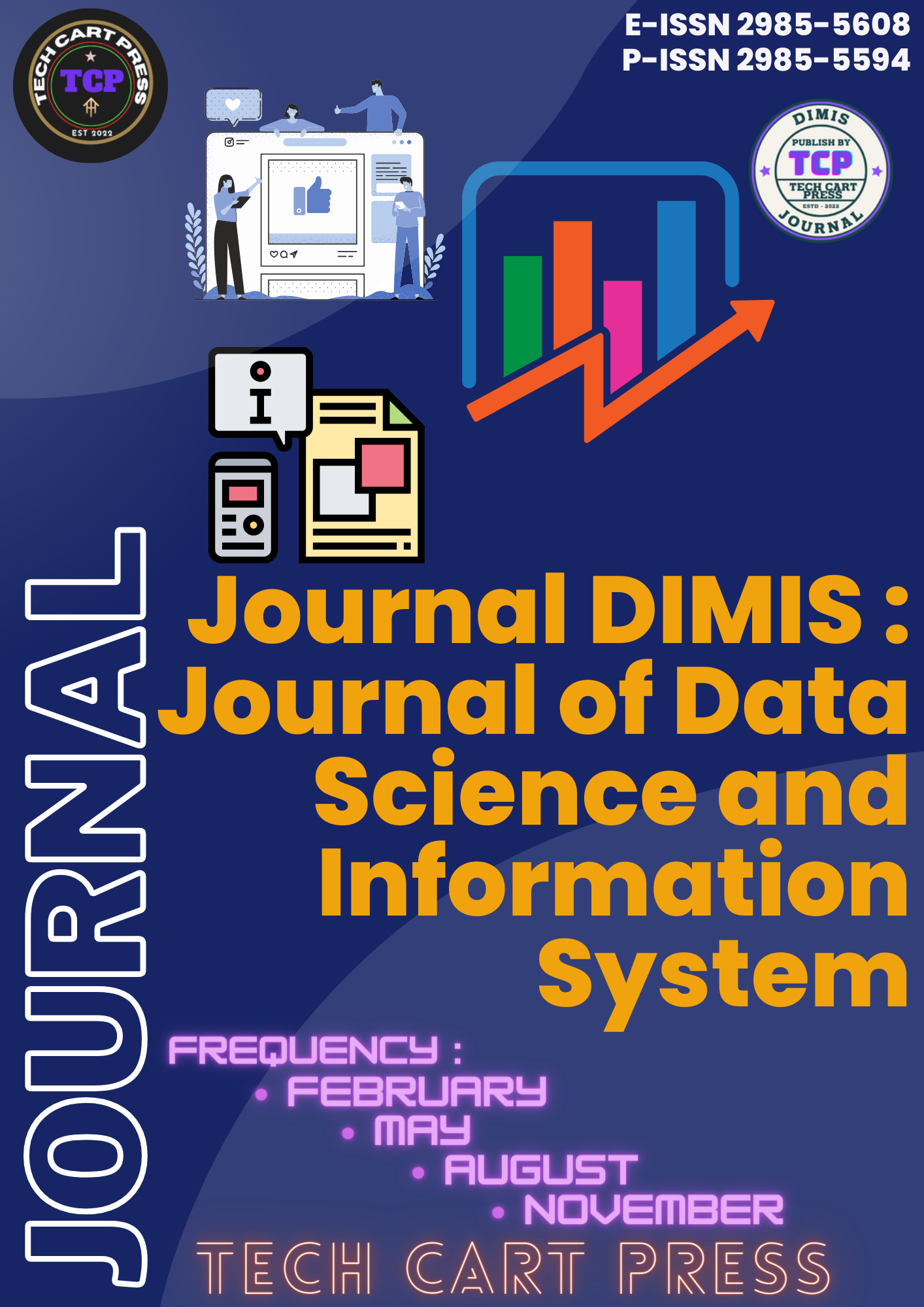Metode Simple Multi-Attribute Rating Technique (SMART) dan Rank Reciprocal (RR) dalam Penentuan Penerima Beasiswa
Abstract
The determination of scholarship recipients is a very important process in supporting the development of individual potential and the empowerment of human resources. This decision not only focuses on academic achievement, but also considers other aspects that reflect leadership values, social contributions, and economic needs. This study aims to apply the SMART method and the Reciprocal Rank weighting method in producing a decision to determine scholarship recipients at SMP XYZ. Weighting using Reciprocal Rank (RR) involves determining the relative weights for each criterion in decision making, and the Simple Multi-Attribute Rating Technique (SMART) can enrich and enhance the assessment process. The final result of ranking scholarship recipients with the integration of the Reciprocal Rank (RR) weighting method and Simple Multi-Attribute Rating Technique (SMART) showed rank 1 with a SMART final score of 0.752 obtained for alternative Student C, 2nd place with a SMART final grade of 0.679 obtained for alternative Student A, 3rd place with a final SMART score of 0.665 obtained for alternative Student B.
References
S. Setiawansyah, A. Surahman, A. T. Priandika, and S. Sintaro, Penerapan Sistem Pendukung Keputusan pada Sistem Informasi. Bandar Lampung: CV Keranjang Teknologi Media, 2023. [Online]. Available: https://buku.techcartpress.com/detailebook?id=1/penerapan-sistem-pendukung-keputusan-pada-sistem-informasi/setiawansyah-ade-surahman-adhie-thyo-priandika-sanriomi-sintaro
A. Herdiansyah, J. F. Andry, S. Setiawansyah, Y. M. Kristania, and S. Sintaro, Sistem pendukung keputusan strategis menggunakan ranking methods. Bandar Lampung: CV. Keranjang Teknologi Media. [Online]. Available: https://buku.techcartpress.com/detailebook.php?id=24
M. N. D. Satria and V. H. Saputra, “Sistem Pendukung Keputusan Pemilihan Karyawan Teladan Menggunakan Metode Simple Multi-Attribute Rating Technique,” J. Media Swarnadwipa, vol. 1, no. 1, pp. 7–13, 2023.
A. F. O. Pasaribu and V. H. Saputra, “Aplikasi Sistem Pendukung Keputusan Penerimaan Staff Video Editing Menggunakan Metode Profile Matching Berbasis Web,” J. Media Borneo, vol. 1, no. 2, pp. 76–84, 2023.
D. Handoko, “Multi-Objective Optimization on the basis of Ratio Analysis (MOORA) Dalam Penentuan Lokasi Pemasaran Produk,” J. Media Celeb., vol. 1, no. 2, pp. 86–92, 2024.
S. Sintaro and T. Yulianti, “SPK Pemilihan Calon Mekanik pada Perusahaan Transportasi Antar Kota Menggunakan Metode Analytic Hierarki Process (AHP),” J. Media Celeb., vol. 1, no. 2, pp. 66–75, 2024.
W. Saputra, S. A. Wardana, H. Wahyuda, and D. A. Megawaty, “Penerapan Kombinasi Metode Multi-Attribute Utility Theory (MAUT) dan Rank Sum Dalam Pemilihan Siswa Terbaik,” J. Inf. Technol. Softw. Eng. Comput. Sci., vol. 2, no. 1, pp. 12–21, 2024.
A. Iskandar, “Sistem Pendukung Keputusan Kelayakan Penerima Bantuan Dana KIP Kuliah Menggunakan Metode ROC-EDAS,” Build. Informatics, Technol. Sci., vol. 4, no. 2 SE-Articles, Sep. 2022, doi: 10.47065/bits.v4i2.2265.
J. Zhang, C. Wu, X. Yu, and X. Lei, “A Novel DenseNet Generative Adversarial Network for Heterogenous Low-Light Image Enhancement,” Frontiers in Neurorobotics, vol. 15. Frontiers Media SA, 2021. doi: 10.3389/fnbot.2021.700011.
H. I. Santoso, “Seleksi Penerimaan Programmer Menggunakan Simple Multi Attribute Rating Technique Method (SMART Method) dan Rank Order Centroid,” J. Inf. Technol. Softw. Eng. Comput. Sci., vol. 2, no. 1, pp. 31–39, 2024.
U. Hairah and E. Budiman, “Kinerja Metode Rank Sum, Rank Reciprocal dan Rank Order Centroid Menggunakan Referensi Poin Moora (Studi Kasus: Bantuan Kuota Data Internet untuk Mahasiswa),” J. Teknol. Inf. dan Ilmu Komput., vol. 9, no. 6, pp. 1129–1136, 2022.
S. Kumar, A. Sinha, S. Jana, R. Mishra, and S. R. Singh, “Jack-flood at SemEval-2023 Task 5: Hierarchical Encoding and Reciprocal Rank Fusion-Based System for Spoiler Classification and Generation,” in Proceedings of the The 17th International Workshop on Semantic Evaluation (SemEval-2023), 2023, pp. 1906–1915.
L. Azzopardi, J. Mackenzie, and A. Moffat, “ERR is not C/W/L: Exploring the relationship between expected reciprocal rank and other metrics,” in Proceedings of the 2021 ACM SIGIR International Conference on Theory of Information Retrieval, 2021, pp. 231–237.
X. Lu, J. Wu, and J. Yuan, “Optimizing Reciprocal Rank with Bayesian Average for improved Next Item Recommendation,” in Proceedings of the 46th International ACM SIGIR Conference on Research and Development in Information Retrieval, 2023, pp. 2236–2240.
D. Handayani, Y. Yudiana, and Y. Wahyudin, “Rancang Bangun Sistem Penunjang Keputusan Penentuan Penerima Beasiswa Menggunakan Metode Simple Additive Weighting,” J. Interkom J. Publ. Ilm. Bid. Teknol. Inf. dan Komun., vol. 15, no. 3, pp. 134–143, 2020.
A. Setiyowati, L. A. Ramadhani, and M. K. Amin, “Sistem Pendukung Keputusan Menentukan Penerima Beasiswa Kurang Mampu Menggunakan Metode Profile Matching,” J. Inform. Upgris, vol. 6, no. 1, 2020.
A. R. Isnain, “Metode Multi-Objective Optimization on the Basis of Simple Ration Analysis Dalam Penentuan Penerima Beasiswa,” J. Ilm. Comput. Sci., vol. 2, no. 1, pp. 29–38, 2023, doi: 10.58602/jics.v2i1.14.
H. Sulistiani, Setiawansyah, P. Palupiningsih, F. Hamidy, P. L. Sari, and Y. Khairunnisa, “Employee Performance Evaluation Using Multi-Attribute Utility Theory (MAUT) with PIPRECIA-S Weighting: A Case Study in Education Institution,” in 2023 International Conference on Informatics, Multimedia, Cyber and Informations System (ICIMCIS), 2023, pp. 369–373. doi: 10.1109/ICIMCIS60089.2023.10349017.
Setiawansyah, A. A. Aldino, P. Palupiningsih, G. F. Laxmi, E. D. Mega, and I. Septiana, “Determining Best Graduates Using TOPSIS with Surrogate Weighting Procedures Approach,” in 2023 International Conference on Networking, Electrical Engineering, Computer Science, and Technology (IConNECT), 2023, pp. 60–64. doi: 10.1109/IConNECT56593.2023.10327119.
Copyright (c) 2024 Sitna Hajar Hadad

This work is licensed under a Creative Commons Attribution-ShareAlike 4.0 International License.






